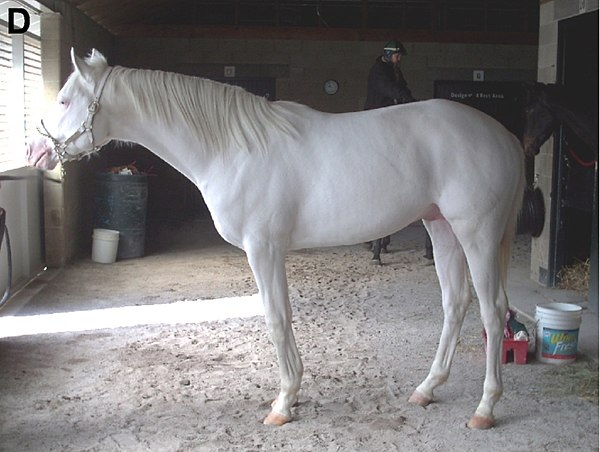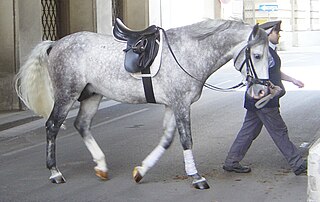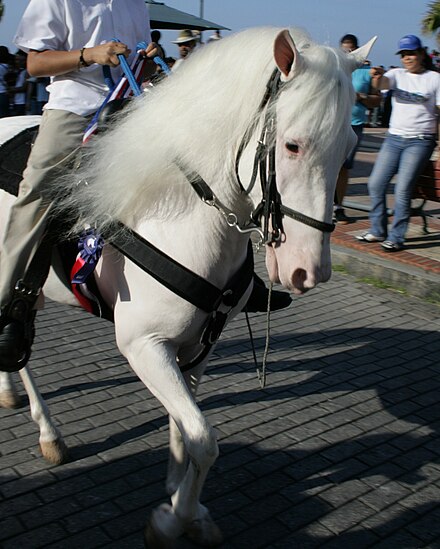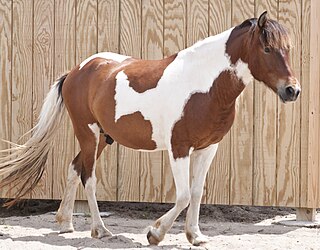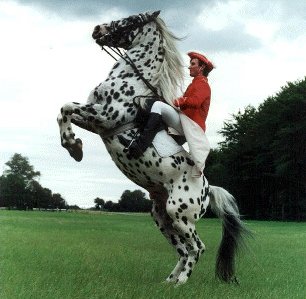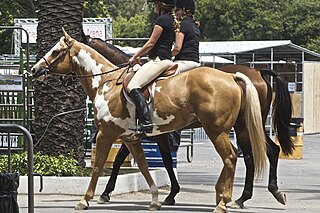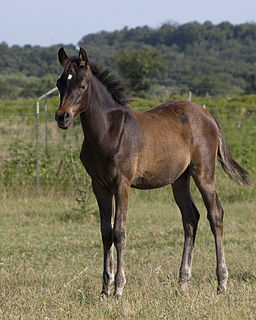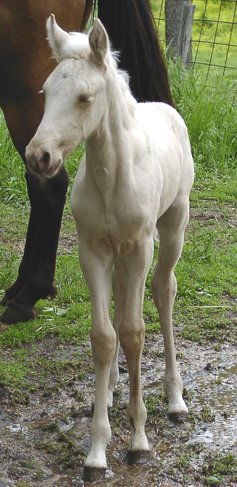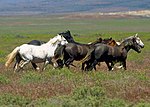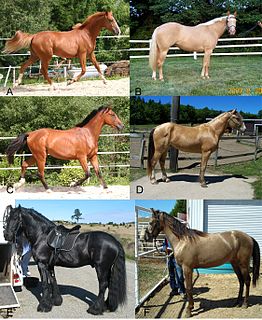
A dilution gene is any one of a number of genes that act to create a lighter coat color in living creatures. There are many examples of such genes:

Lethal white syndrome (LWS), also called overo lethal white syndrome (OLWS), lethal white overo (LWO), and overo lethal white foal syndrome (OLWFS), is an autosomal genetic disorder most prevalent in the American Paint Horse. Affected foals are born after the full 11-month gestation and externally appear normal, though they have all-white or nearly all-white coats and blue eyes. However, internally, these foals have a nonfunctioning colon. Within a few hours, signs of colic appear; affected foals die within a few days. Because the death is often painful, such foals are often humanely euthanized once identified. The disease is particularly devastating because foals are born seemingly healthy after being carried to full term.

A piebald or pied animal is one that has a pattern of unpigmented spots (white) on a pigmented background of hair, feathers or scales. Thus a piebald black and white dog is a black dog with white spots. The animal's skin under the white background is not pigmented.
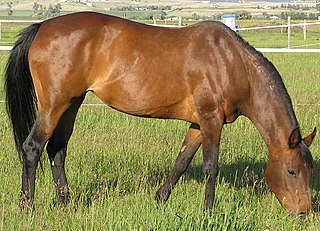
Bay is a hair coat color of horses, characterized by a brown body color with a black mane, tail, ear edges, and lower legs. Bay is one of the most common coat colors in many horse breeds.

The cream gene is responsible for a number of horse coat colors. Horses that have the cream gene in addition to a base coat color that is chestnut will become palomino if they are heterozygous, having one copy of the cream gene, or cremello, if they are homozygous. Similarly, horses with a bay base coat and the cream gene will be buckskin or perlino. A black base coat with the cream gene becomes the not-always-recognized smoky black or a smoky cream. Cream horses, even those with blue eyes, are not white horses. Dilution coloring is also not related to any of the white spotting patterns.

The champagne gene is a simple dominant allele responsible for a number of rare horse coat colors. The most distinctive traits of horses with the champagne gene are the hazel eyes and pinkish, freckled skin, which are bright blue and bright pink at birth, respectively. The coat color is also affected: any hairs that would have been red are gold, and any hairs that would have been black are chocolate brown. If a horse inherits the champagne gene from either or both parents, a coat that would otherwise be chestnut is instead gold champagne, with bay corresponding to amber champagne, seal brown to sable champagne, and black to classic champagne. A horse must have at least one champagne parent to inherit the champagne gene, for which there is now a DNA test.

Equine coat color genetics determine a horse's coat color. Many colors are possible, but all variations are produced by changes in only a few genes. Extension and agouti are particularly well-known genes with dramatic effects. Differences at the agouti gene determine whether a horse is bay or black, and a change to the extension gene can make a horse chestnut instead. Most domestic horses have a variant of the dun gene which saturates the coat with color so that they are bay, black, or chestnut instead of dun, grullo, or red dun. A mutation called cream is responsible for palomino, buckskin, and cremello horses. Pearl, champagne and silver dapple also lighten the coat, and sometimes the skin and eyes as well. Genes that affect the distribution of melanocytes create patterns of white such as in roan, pinto, leopard, white, and even white markings. Finally, the gray gene causes premature graying, slowly adding white hairs over the course of several years until the horse looks white. Some of these patterns have complex interactions.

Chestnut is a hair coat color of horses consisting of a reddish-to-brown coat with a mane and tail the same or lighter in color than the coat. Chestnut is characterized by the absolute absence of true black hairs. It is one of the most common horse coat colors, seen in almost every breed of horse.

Horses exhibit a diverse array of coat colors and distinctive markings. A specialized vocabulary has evolved to describe them.

Black is a hair coat color of horses in which the entire hair coat is black. Black is a relatively uncommon coat color, and it is not uncommon to mistake dark chestnuts or bays for black.

Sabino is a group of white spotting patterns in horses that affect the skin and hair. A wide variety of irregular color patterns are accepted as sabino. In the strictest sense, "sabino" refers to the white patterns produced by the Sabino 1 (SB1) gene, for which there is a DNA test. However, other horse enthusiasts also refer to patterns that are visually similar to SB1 as "sabino", even if testing indicates the gene is not present. Use of the term to describe non-SB1 "sabino" patterns in breeds that apparently do not carry the gene is hotly debated by both researchers and horse breeders.

Smoky black is a hair coat color of horses in which the coat is either black or a few shades lighter than true black. Smoky black is produced by the action of a heterozygous cream gene on an underlying black coat color. Therefore, smoky black is a member of the cream family of coat color dilutions, and found in horse populations that have other cream gene-based colors such as palomino, buckskin, perlino and cremello. All smoky blacks must have at least one parent with the cream gene, and a smoky black can be verified through DNA testing. Smoky black has been mistaken for faded black, dark bay or brown, grullo or even liver chestnut.

The leopard complex is a group of genetically related coat patterns in horses. These patterns range from progressive increases in interspersed white hair similar to graying or roan to distinctive, Dalmatian-like leopard spots on a white coat. Secondary characteristics associated with the leopard complex include a white sclera around the eye, striped hooves and mottled skin. The leopard complex gene is also linked to abnormalities in the eyes and vision. These patterns are most closely identified with the Appaloosa and Knabstrupper breeds, though it is due to a very ancient mutation and used to be widespread.

Amelanism is a pigmentation abnormality characterized by the lack of pigments called melanins, commonly associated with a genetic loss of tyrosinase function. Amelanism can affect fish, amphibians, reptiles, birds, and mammals including humans. The appearance of an amelanistic animal depends on the remaining non-melanin pigments. The opposite of amelanism is melanism, a higher percentage of melanin.

Seal brown is a hair coat color of horses characterized by a near-black body color; with black points, the mane, tail and legs; but also reddish or tan areas around the eyes, muzzle, behind the elbow and in front of the stifle. The term is not to be confused with "brown", which is used by some breed registries to refer to either a seal brown horse or to a dark bay without the additional characteristics of seal brown genetics.

Roan is a horse coat color pattern characterized by an even mixture of colored and white hairs on the body, while the head and "points"—lower legs, mane and tail—are mostly solid-colored. Horses with roan coats have white hairs evenly intermingled throughout any other color. The head, legs, mane and tail have fewer scattered white hairs or none at all. The roan pattern is dominantly-inherited, and is found in many horse breeds. While the specific mutation responsible for roan has not been exactly identified, a DNA test can determine zygosity for roan in several breeds. True roan is always present at birth, though it may be hard to see until after the foal coat sheds out. The coat may lighten or darken from winter to summer, but unlike the gray coat color, which also begins with intermixed white and colored hairs, roans do not become progressively lighter in color as they age. The silvering effect of mixed white and colored hairs can create coats that look bluish or pinkish.

In poultry standards, solid white is coloration of plumage in chickens characterized by a uniform pure white color across all feathers, which is not generally associated with depigmentation in any other part of the body.
